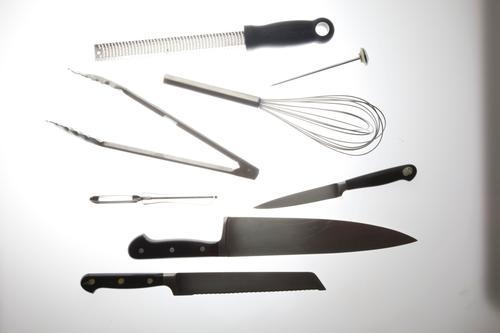
Flames, electric appliances,
hot stoves, sharp knives, slippy floors. The kitchen can be a dangerous
place. We asked Alison Jacobson, a national family safety and wellness
expert known as The Safety Mom, for suggestions to keep us—and our
families—safe while we cook.
1. Check your smoke alarm batteries
You know the rule of thumb: Check them in the fall and spring, when the clocks change. But it doesn’t hurt to do a monthly test as well. Sick of false alarms? Jacobson recommends the combination fire alarm (see #2) so you won’t disable the alarm when you burn toast and forget to reset it.
2. Install a combination smoke alarm
"It’s recommended that a smoke detector that uses photoelectric technology rather than the standard ionization alarm be installed in kitchens," Jacobson tells us. "Ionization alarms detect fast-flaming fires; The photoelectric alarm detects smoldering fires."
Best option? “A combination photoelectric/ionization alarm, such as this one from First Alert,” she adds. “If you currently have an ionization alarm, it should be at least 10 feet away from cooking appliances.”
3. Check your carbon-monoxide alarm batteries
Why? “When a gas oven is malfunctioning, carbon monoxide (CO) can build up in your kitchen. “Hundreds of Americans die accidentally every year from CO poisoning caused by malfunctioning or improperly used fuel-burning appliances,” warns Jacobson.
4. Make sure you have enough carbon-monoxide alarms
"It’s important to have a CO detector installed on every floor of your home to alert you of elevated levels of CO. Symptoms of CO poisoning include headaches, dizziness, shortness of breath, and nausea. If anyone in your family is experiencing these symptoms, turn off the gas oven and leave immediately!” Jacobson stresses.
5. Have your oven inspected annually by a professional or your gas company
6. Buy a good fire extinguisher…
"Kidde’s Kitchen Fire Extinguisher is a great choice," says Jacobson, "as it’s specifically designed for kitchen grease fires—never try to put out a grease fire with water, as that could actually cause it to increase."
7. …and put it in a practical place
"The best place to put the fire extinguisher is by the door of the kitchen so you have easy access."
8. Buy a fire blanket
"Fire blankets are another safety item that should be in all kitchens," says Jacobson. "They are designed to extinguish small, starting fires."
9. Feel the casing of your microwave
"If the outside of the microwave becomes very hot, this could be a sign of trouble," Jacobsen warns.
10. Inspect the microwave power cord
"It’s always important to check the electrical cord of your microwave for any fraying or damage on a regular basis. And if your circuit breaker frequently trips when you’re using it, this could be a sign of a serious electrical issue.
"It’s always important to check the electrical cord of your microwave for any fraying or damage on a regular basis. And if your circuit breaker frequently trips when you’re using it, this could be a sign of a serious electrical issue.
11. Don’t try to fix your microwave!
"Most importantly, if you suspect there is a problem with your microwave, never try to repair it yourself! There are numerous cases of people electrocuting themselves trying to fix their microwave," cautions Jacobson.
12. Check for microwave recall notices
Jacobson tells us: “In 2013, a Consumer Reports article detailed troubling issues with some microwaves that were turning on by themselves, in particular KitchenAid and GE models. These two manufacturers had the most fire-related microwave complaints on SaferProducts.gov, a Consumer Product Safety Commission website.”
13. Mail in manufacturer’s warranty information
"It’s important that you submit manufacturer’s warranty information so you can be contacted in the event of a recall," says Jacobson. "If you’ve moved into a home with a built-in microwave and are unsure, visit theCPSC website and research whether there’s been a recall with your oven."
14. Buy a nonslip mat for your kitchen
"Falls in the home are one of the leading causes of injury for people of every age. There are low-profile floor mats available in every color to match your flooring. These should be placed in areas where liquids and oils are most likely to spill, including in front of the refrigerator, sink, stove, and garbage."
"Falls in the home are one of the leading causes of injury for people of every age. There are low-profile floor mats available in every color to match your flooring. These should be placed in areas where liquids and oils are most likely to spill, including in front of the refrigerator, sink, stove, and garbage."
15. Choose top-quality oven mitts
Jacobson loves silicone mitts with cloth linings:
* They offer the best protection for heat up to at least 450 degrees F.
* They’re easy to clean, and therefore there’s less concern about bacteria or mold.
* The cloth lining making gripping easier, and therefore there’s less chance of dropping a hot dish or pan.
One of the biggest dangers with cloth mitts is that when they get wet, they can burn terribly. Silicone mitts are waterproof, eliminating this concern.
16. Keep your knives sharp
"Dull knives lead to more injuries. A dull knife requires you to use more pressure, which leads to a greater risk of you losing control of it," warns Jacobson.
17. Wear shoes when using a knife!
"If it accidentally drops, quickly step back and don’t try to catch it!"
18. Be careful cleaning knives
Double-check when you’re cleaning a knife to be sure the sharp side is pointing away from you.
19. Store knives sensibly
"Store knives in a wooden block, never in a drawer, and make sure it is pushed far back on the counter so kids can’t reach it."
20. Give children a kitchen safety zone"Create an area for your child to play safely away from the sink and stove where boiling water could be spilled or a knife dropped," says Jacobson.
21. Keep appliances and cords out of reach of kids
"It’s amazing how far little arms can reach. Be sure that all electrical appliances are pushed far back on the counter and no cords are dangling."
"It’s amazing how far little arms can reach. Be sure that all electrical appliances are pushed far back on the counter and no cords are dangling."
22. Don’t let children get up to the counter
"Keep step stools and benches locked away in closets to prevent little ones from climbing up onto the counter."
23. Lock spices away from children
"While spices are a staple in every kitchen, certain ones can be toxic to children—keep them stored in a high cabinet, preferably with a lock on it," Jacobson advises.
24. Give seniors living alone gadgets to keep them safe in the kitchen
"Due to cognitive impairments such as dementia, the elderly are particularly at risk for kitchen fires due to unattended cooking."
Orignal Article at: 24 Ways to Stay Safe in the Kitchen
By: Joanne Camas
